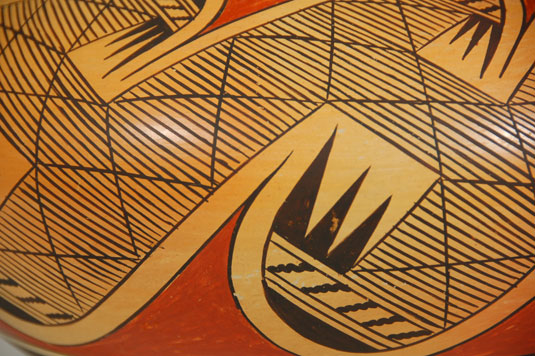Very Large Polychrome Jar with Migration Pattern [SOLD]
+ Add to my watchlist Forward to Friend
- Category: Modern
- Origin: Hopi Pueblo, Hopituh Shi-nu-mu
- Medium: clay, pigment
- Size: 8-1/8” height x 12-3/8” diameter
- Item # C3730A SOLD
This seed jar is probably from the 1970s or earlier and is an excellent example of the fine work of Fannie Nampeyo. It was beautifully formed, polished, and painted with precision. The tip of the rim rolls out in the manner that Nampeyo frequently used. The parallel black migration lines are remarkably straight and parallel. The orange paint was applied in an even consistency of darkness and a beautiful blush was achieved during firing. The low and wide globular vessel form is particularly striking. The widest part of the vessel is at mid-body.
 Collectors never tire of Hopi-Tewa pottery with the migration pattern as it is a design that fills the area of the vessel completely and has a dynamic flow of a wave in the ocean. One can feel the motion as if the breakers were crashing against the beach. Of course, that is not the inspiration for the design, just a feeling I get when seeing the pattern.
Collectors never tire of Hopi-Tewa pottery with the migration pattern as it is a design that fills the area of the vessel completely and has a dynamic flow of a wave in the ocean. One can feel the motion as if the breakers were crashing against the beach. Of course, that is not the inspiration for the design, just a feeling I get when seeing the pattern.
Fannie Nampeyo was the youngest daughter of Nampeyo of Hano and, as a result, is the daughter most remembered by collectors from the 20th century. Her older sister Annie had passed away in 1968 and her other sister Nellie in 1978. Fannie lived until 1987. She was still an active potter in the mid-80s and was very welcoming to visitors to her home, therefore many collectors knew her personally. I visited her frequently during that decade and am glad to have known her. She was the first one to demonstrate to me putting petroleum jelly on her fired pottery and then polishing it with old nylon hosiery. That is the reason that the paint on her pottery does not smear or rub off easily.
Many members of the Nampeyo family are potters and a number of them use the migration pattern on their works but there is a sense that the older generation understood its meaning as they lovingly applied it to a finished vessel. It was part of their ancestral history.
Condition: excellent condition
Recommended Reading: Hopi-Tewa Pottery: 500 Artist Biographies by Gregory and Angie Schaaf
Provenance; from a New Mexico family

- Category: Modern
- Origin: Hopi Pueblo, Hopituh Shi-nu-mu
- Medium: clay, pigment
- Size: 8-1/8” height x 12-3/8” diameter
- Item # C3730A SOLD



